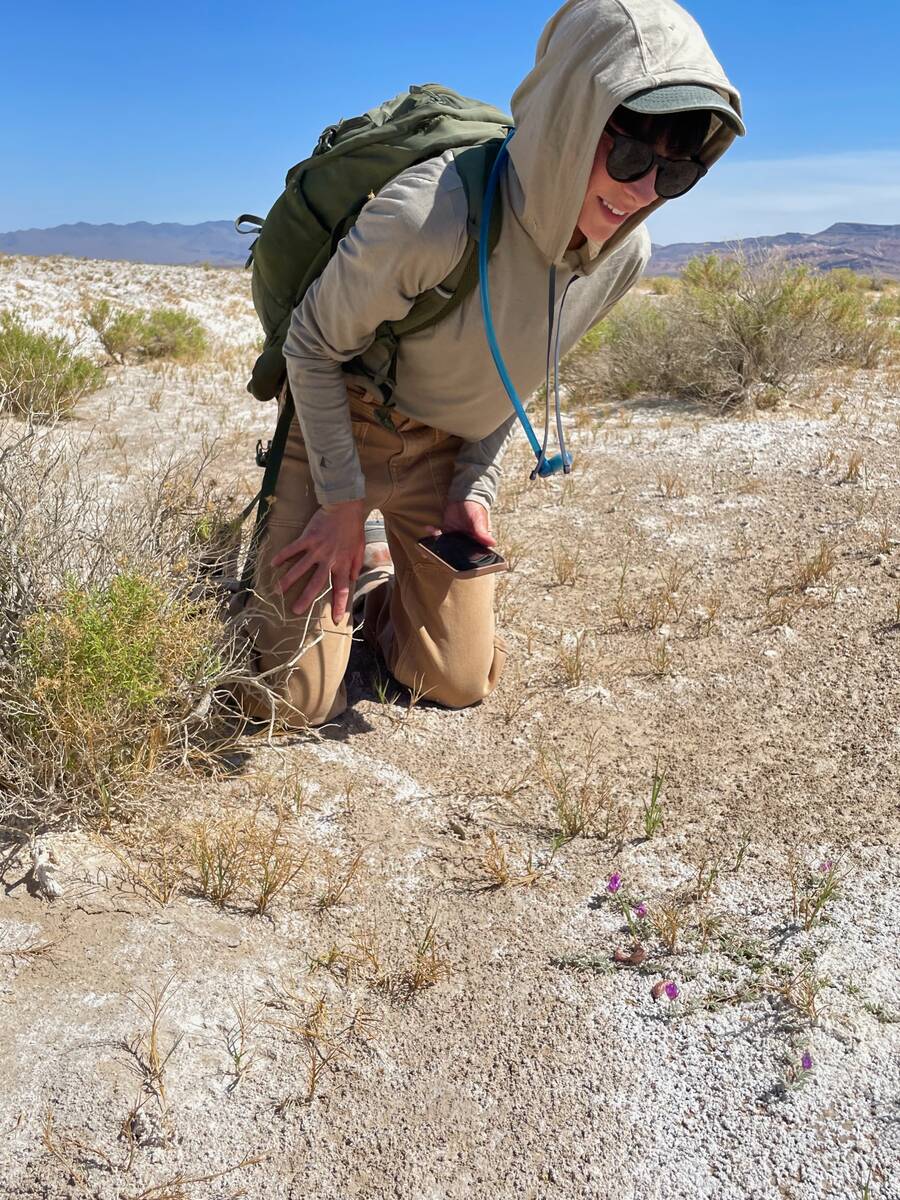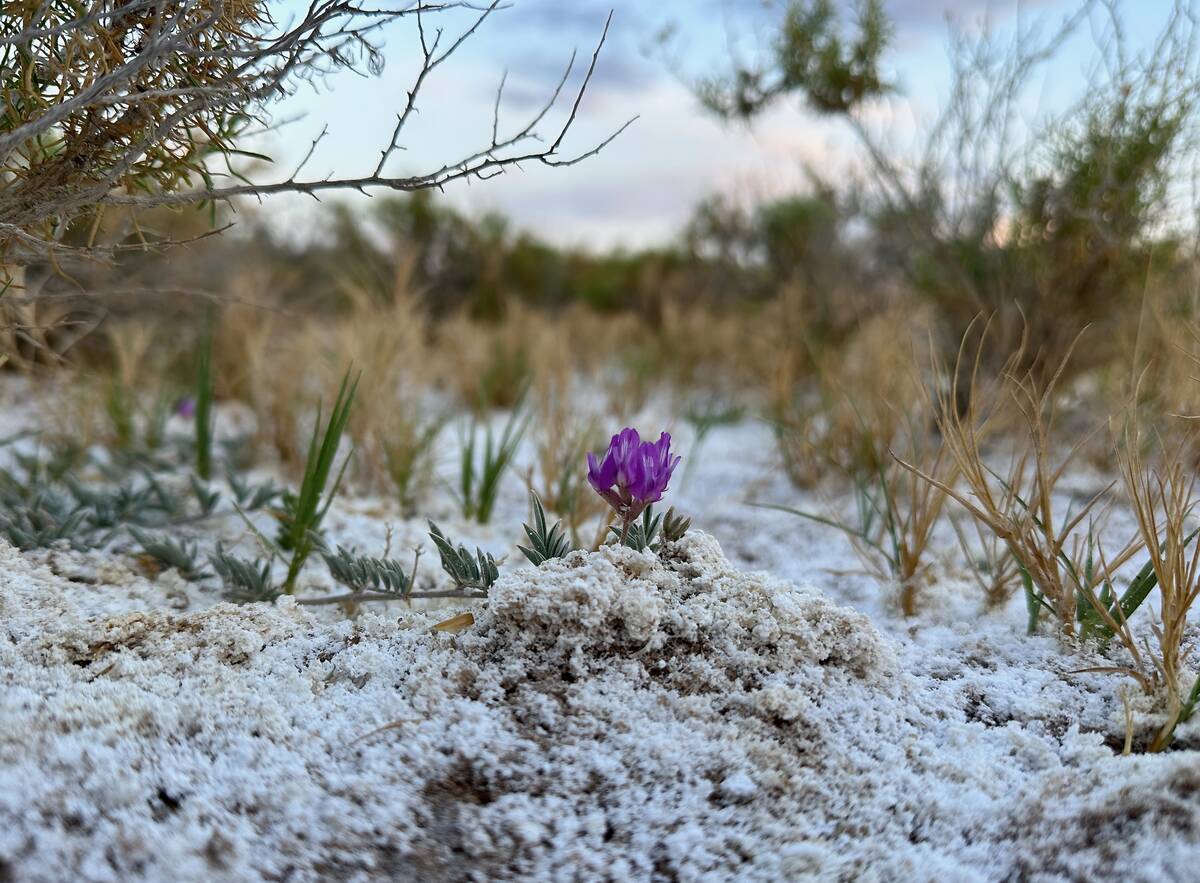A flower could slow construction of NV Energy’s costly transmission line
On one of her trips to rural western Nevada, California Botanic Garden master’s student Chloe Novak found herself confronted with the beginnings of an extinction crisis.
ATV tracks and wooden stakes riddled the silty floor of Sarcobatus Flat, where she had spent been surveying a population of an extremely rare, state-protected purple flower: the sodaville milkvetch.
NV Energy contractors had passed through, showing little regard for the plant, marking the path of the multi-billion-dollar Greenlink West transmission line to which the Bureau of Land Management granted final approval of last September. The line, which will connect Las Vegas to the Reno area, is expected to be constructed and in service by May 2027.
“It was a shock,” Novak recalled in an interview. “I really couldn’t believe what I was seeing.”
Nevada’s untested plant protections
Novak’s discovery of between 335 and 470 plants in this area about 10 miles northwest of Beatty in Nye County, could prove to be a roadblock for the transmission line, a project that’s meant to allow massive solar farms to transmit energy to Nevada’s urban centers.
Five populations of the plant live in Nevada. Another resides across the border in California, which is protected because it’s within Death Valley National Park and by the California Endangered Species Act, generally considered a stronger law than that of Nevada.
“These plants are so restricted and so rare because they only occur in a tiny fraction of this huge basin,” Novak said. “That makes it harder to accept that this is the only place that this transmission line could go in such a big area.”
Rather than being protected under the powerful federal Endangered Species Act, the Silver State’s populations’ only defense is instead Nevada’s little-known endangered plant statutes. In order to remove or destroy the plant, NV Energy must obtain a permit from the Nevada Division of Forestry, according to state law.
But so far, NV Energy hasn’t fulfilled that obligation and the Forestry Division hasn’t intervened.
In a statement on Tuesday, Nevada state forester Kacey KC confirmed the Forestry Division hadn’t received a permit application related to the sodaville milkvetch but said it’s working with the BLM and contractors to address the issue. The BLM declined to comment on the issue.
An NV Energy spokesperson didn’t respond to questions about the plant or the required permit, instead broadly saying it is committed to minimizing environmental impacts while proceeding with the project with its federal permits.
Nevada’s “toothless” endangered plant statutes haven’t been tested before in court, said Patrick Donnelly, Great Basin director of the Center for Biological Diversity, a nonprofit that regularly files environmental lawsuits in Nevada.
The law doesn’t list penalties for not abiding by it, nor does it have a clause like the federal Endangered Species Act that suggests lawsuits could be filed to challenge decisions made under the law.
Because the Bureau of Land Management’s environmental review documents didn’t mention the sodaville milkvetch and NV Energy hasn’t been awarded the permit, Donnelly wrote a letter to the Forestry Division and BLM pointing out the issue and providing Novak’s documentation of the destruction.
“It was clear to me that this population faces utter annihilation if construction proceeds as currently staked out,” Donnelly wrote in the letter.
Court battle looms
The future of the sodaville milkvetch population at Sarbocatus Flat remains unclear.
Novak and Donnelly are working together to file a petition for the Fish and Wildlife Service to list it federally, which would require any related project like the transmission line to avoid the plant or its habitat.
But to get it listed could require a court battle if the Fish and Wildlife Service misses deadlines to respond, Donnelly said. A similar, high-profile scenario played out nearby when Donnelly successfully petitioned the agency to list Tiehm’s buckwheat, a wildflower in the direct path of a lithium-boron mine in Esmeralda County.
In the meantime, Nevada’s endangered plant statutes could be put to the test in court if the Forestry Division fails to meet its legal obligation to protect the sodaville milkvetch from the construction, Donnelly said.
“If we were to decide to litigate, it would be a novel intervention that no one’s ever tried before,” Donnelly said. “It’s not going to be like an easy decision because we got to figure out if that’s a lawsuit we could win.”
Aside from potentially destroying a large portion of a species she has spent years documenting, Novak said the transmission line is yet another example of how resource extraction is contributing to the world’s biodiversity crisis.
“We are truly losing species faster than we can describe them and document them,” Novak said. “The impacts of that are hard to really fathom because we do not know a way of human existence that is not plant-dependent. We need plants. We really do, for just about everything.”
Contact Alan Halaly at ahalaly@reviewjournal.com. Follow @AlanHalaly on X.






















